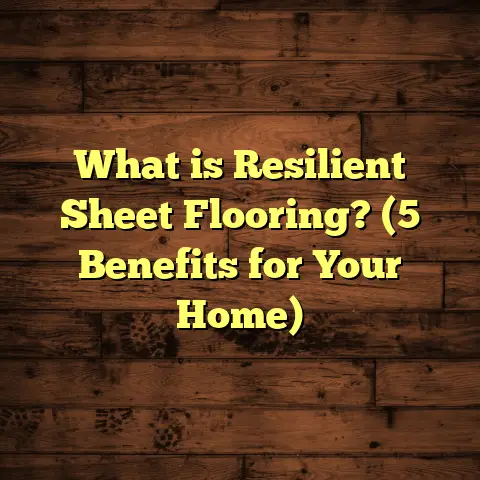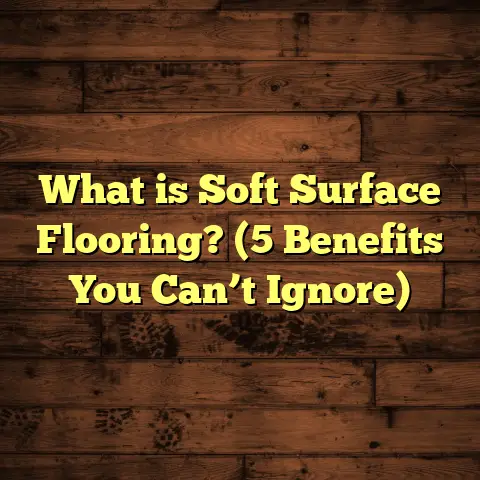What is Better: Ceramic Tile or Vinyl Flooring? (5 Key Comparisons)
Have you ever stood in a home improvement store aisle, staring at endless flooring options and wondered, “Which one is really better for my home — ceramic tile or vinyl flooring?” I know I have. Choosing the right flooring feels overwhelming at times, especially when both options promise durability, style, and affordability. Over the years, I’ve worked on dozens of flooring projects, and I’ve learned that the choice between ceramic tile and vinyl isn’t just about looks—it’s about understanding how each material performs in real-world settings.
What Is Ceramic Tile and Vinyl Flooring?
Before we get into the nitty-gritty comparisons, let me explain what ceramic tile and vinyl flooring actually are.
Ceramic tile is made from natural clay that’s fired in a kiln at very high temperatures—sometimes as high as 2,200 degrees Fahrenheit. This process hardens the clay and gives ceramic tile its signature strength and durability. After firing, ceramic tiles are often glazed with a protective coating that can come in various colors, finishes, and textures. Because of their hard surface and water resistance, ceramic tiles are commonly used in kitchens, bathrooms, hallways, and even outdoor patios where moisture can be an issue.
There are two main types of ceramic tile: glazed and unglazed. Glazed tiles have a glass-like coating that offers more color options and stain resistance but can be slippery when wet. Unglazed tiles are rougher and provide better traction but might stain more easily.
Vinyl flooring, on the other hand, is a completely different beast. It’s a synthetic product made primarily from polyvinyl chloride (PVC) combined with plasticizers to make it flexible and durable. Vinyl comes in various forms: sheets, tiles (often called VCT – Vinyl Composition Tile), and luxury vinyl planks (LVP), which mimic natural materials like wood and stone.
Vinyl flooring became popular in the mid-20th century due to its affordability and ease of maintenance. Today’s vinyl products are much more advanced, featuring thick wear layers, realistic textures, and waterproof qualities that help them compete head-to-head with ceramic tiles in many environments.
My Experience with Both Materials
I remember early in my career installing ceramic tile in a family bathroom. The client wanted something classic but functional. The process took several days—from preparing the subfloor to laying tiles with precision and grouting carefully. The result was stunning—a timeless floor that still looks great 15 years later.
Contrast that with a project I did last year in a rental apartment where vinyl plank flooring was installed. It was a quick turnaround job with tenants moving in soon. The vinyl was easy to cut and lay over the existing floor. It looked surprisingly elegant and has held up well despite heavy foot traffic.
These experiences shaped my appreciation for both materials—they each have their place depending on the project’s requirements.
1. Durability and Lifespan: Which Holds Up Better?
Let’s start with durability—probably one of the most critical factors when choosing flooring.
Ceramic tile is famously durable. The firing process creates a hard surface that resists scratches, dents, stains, and water intrusion. That’s why you see ceramic tiles used in commercial kitchens, busy hotels, and public restrooms. They can withstand heavy foot traffic without showing signs of wear for decades.
In fact, I’ve seen homes where original ceramic tiles from the 1950s are still intact with only minor grout repairs needed. That’s not an exaggeration.
Vinyl flooring’s durability varies widely depending on quality. Entry-level vinyl sheets might last 5 to 7 years before showing wear, especially in high-traffic areas. Luxury vinyl planks (LVP), which have thicker wear layers (usually between 12-30 mils), can last 10-15 years or more with proper care.
A recent report by the North American Flooring Association found that high-quality vinyl floors had a failure rate of less than 5% after 10 years in residential settings. That’s impressive for a relatively young product category.
However, vinyl is softer than ceramic tile, meaning it can dent or gouge if sharp objects fall on it or if heavy furniture is dragged across it without protection.
Real-World Case Study
I installed ceramic tile in a restaurant kitchen back in 2017. The kitchen staff was tough on floors — dropping knives, dragging heavy carts — yet five years later, the floor still looked almost brand new with just routine cleaning.
In contrast, a luxury vinyl floor I installed in a daycare center three years ago has some minor gouges from toys and furniture legs but no cracks or peeling. The daycare owner appreciated how warm and quiet vinyl was compared to tile’s hardness.
Summary of Durability Factors
| Attribute | Ceramic Tile | Vinyl Flooring |
|---|---|---|
| Scratch resistance | Very high | Moderate |
| Dent resistance | Very high | Moderate to low |
| Water resistance | Excellent | Excellent |
| Impact resistance | Moderate (can crack if dropped heavy objects) | Good (flexible but can dent) |
| Lifespan | 20-30 years or more | 10-15 years (luxury vinyl) |
2. Installation Process: DIY Friendly or Professional Job?
I want to share some personal stories here because installation often surprises homeowners more than they expect.
Ceramic tile installation is definitely more labor-intensive. I’ve worked alongside professional tilers who spend hours prepping subfloors to be perfectly level because even small bumps cause tiles to crack or look uneven.
The installation process involves:
- Preparing the subfloor (often reinforcing or leveling)
- Spreading thin-set mortar evenly
- Laying tiles carefully using spacers for consistent grout lines
- Allowing mortar to set before grouting
- Sealing grout lines after curing
It’s precise work that requires patience and skill. I once saw an enthusiastic DIYer attempt tile installation without proper tools or prep—resulting in cracked tiles and uneven grout lines that needed professional repair later.
Vinyl installation is much more forgiving for beginners. Many luxury vinyl planks come with click-lock systems that snap together easily without glue or nails. You can install vinyl over many existing floors as long as they’re clean and relatively smooth.
Vinyl sheets require adhesive but are still simpler than tile mortar application. Installation times range from a few hours for small rooms to one full day for larger spaces—much faster than tile installations that can span multiple days.
Tips from My Experience Installing Floors
- For ceramic tile projects: Always hire a professional unless you’re very experienced.
- For vinyl: DIY is doable if you follow manufacturer instructions carefully.
- For both: Subfloor condition is crucial; uneven surfaces cause headaches regardless of material.
3. Aesthetic Appeal and Design Options
I often get asked about how ceramic tile and vinyl compare visually because style matters just as much as function.
Ceramic tile offers classic beauty that lasts forever. You can find countless shapes, sizes, colors, patterns, and finishes—from glossy subway tiles to textured stone-look tiles. Some manufacturers even offer hand-painted or artisanal designs for custom looks.
Vinyl flooring’s biggest advantage is its versatility at a lower price point. Modern printing technology allows vinyl to replicate wood grain, marble veins, concrete textures, or even intricate tile patterns beautifully.
In fact, some luxury vinyl products now include embossed textures that make you want to reach down and feel them because they’re so realistic.
Here’s a story: A client wanted wood floors but had two large dogs and kids. We chose luxury vinyl planks with a distressed oak look that fooled everyone visiting their home—even their friends were surprised it wasn’t real wood!
Design Trends and Innovations
- Ceramic: Large-format tiles are popular now because they create fewer grout lines and a sleek look.
- Vinyl: Mixed-width planks and varied color tones add depth and character.
- Both materials are available in eco-friendly options like recycled content tiles or phthalate-free vinyl.
Design Cost Comparison
| Design Feature | Ceramic Tile | Vinyl Flooring |
|---|---|---|
| Color/pattern variety | Very wide | Very wide |
| Texture options | Smooth to highly textured | Embossed & textured options |
| Customization | High (handmade & specialty tiles) | Moderate |
| Realism (wood/stone look) | Limited (natural materials only) | Excellent (photographic printing) |
4. Maintenance and Cleaning: What’s Easier to Keep Up?
Here is where I often hear people say “I want something low-maintenance.” Let me tell you what I’ve learned on this front.
Ceramic tile floors are generally easy to keep clean by sweeping or vacuuming regularly and mopping with mild detergent. However, grout lines can become a maintenance headache if neglected—they absorb dirt and moisture leading to discoloration or mold growth if ventilation is poor.
I had a client call me after five years complaining about dirty grout stains in their bathroom tiles. A thorough grout cleaning and sealing fixed the problem but reminded me how important regular upkeep is.
Vinyl floors don’t have grout lines so they avoid this problem entirely—making them attractive for busy households or commercial spaces where speed matters.
But beware: abrasive cleaners or scrubbing pads can damage vinyl surfaces over time so stick with gentle cleaning agents.
Maintenance Tips I Recommend:
- For ceramic tiles:
- Sweep or vacuum daily
- Mop weekly with pH-neutral cleaner
- Seal grout lines every 1–2 years
- Address stains quickly using baking soda paste or commercial grout cleaners
- For vinyl flooring:
- Sweep/dust mop regularly
- Damp mop weekly with mild soap solution
- Avoid waxes or polishes unless manufacturer recommends
- Use felt pads under furniture legs to prevent dents
5. Cost Considerations: Budget vs Long-Term Value
Money talks loud in home improvement projects—so I want to break down costs clearly based on my years of quoting jobs.
Here’s what I typically see:
Material Costs
- Ceramic tile prices vary widely:
- Budget tiles: $1–$3 per sq ft
- Mid-range: $3–$7 per sq ft
- Premium/designer: $8–$15+ per sq ft
- Vinyl flooring prices:
- Basic sheet vinyl: $1–$3 per sq ft
- Mid-range luxury vinyl planks: $3–$5 per sq ft
- High-end LVP: $5–$7 per sq ft
Labor Costs
- Tile installation labor is complex:
- $5–$10+ per sq ft depending on difficulty
- Vinyl installation labor tends to be cheaper:
- $1–$4 per sq ft depending on method
So if you’re looking at a typical 500 sq ft kitchen or bathroom:
| Flooring Type | Material Cost Estimate | Labor Cost Estimate | Total Estimate |
|---|---|---|---|
| Ceramic Tile | $2,500 – $5,000 | $2,500 – $5,000 | $5,000 – $10,000 |
| Luxury Vinyl Plank | $1,500 – $3,500 | $500 – $2,000 | $2,000 – $5,500 |
Long-Term Value Thoughts
Though ceramic tile costs more upfront, its lifespan often makes it more cost-effective over decades since replacements are less frequent.
Vinyl flooring offers a lower initial investment which appeals especially to renters or budget-conscious homeowners who want style without breaking the bank.
Other Important Factors I’ve Learned Over Time
Comfort Underfoot
Ceramic tile feels cold and hard beneath your feet—something I noticed immediately during my first winter installing tile floors without radiant heating underneath! This can be uncomfortable for long periods standing or walking barefoot.
Vinyl floors have some cushioning due to their flexible layers making them warmer and softer—ideal for living rooms or bedrooms where comfort matters most.
Environmental Impact
If you care about sustainability like I do now:
- Ceramic tile production uses natural materials but requires energy-intensive firing.
- Vinyl is made from petrochemicals but newer products include recycled content.
Choosing floors with low VOC emissions is important indoors; both materials have low-VOC options available today.
Repairability
If something breaks:
- Ceramic tiles are brittle; damaged tiles must be replaced individually which can be tricky if matching older styles.
- Vinyl flooring can dent but usually doesn’t crack; damaged sections can sometimes be patched or replaced more easily depending on installation type.
Final Thoughts Based on My Experience
I’m often asked which flooring I’d choose if I were remodeling my own home today.
For wet areas like bathrooms or kitchens where water resistance is paramount? Ceramic tile wins hands down for durability and timeless style — but only if you’re okay with cold floors unless heated underneath.
For family rooms, bedrooms or rental spaces where budget and comfort matter? Vinyl plank flooring offers excellent value with modern styles that look great and hold up well enough for many years without much fuss.
There isn’t one perfect answer — just what fits your priorities best based on use case, budget, maintenance willingness, style preferences, and lifestyle factors like pets/children.
If you want help figuring out exactly what works best for your project specifics — room size, climate conditions, traffic levels — just ask me! Flooring choices shape how your home feels every day; making an informed decision means you’ll enjoy your space far longer without regrets.
Would you like me to walk you through calculating costs using FloorTally or share specific product recommendations based on your style? I’m here to help!





